
|   |

|   |
The celestial Apsaras descend upon Singapore's Esplanade - Dr Sunil Kothari e-mail: sunilkothari1933@gmail.com Photos courtesy: Apsaras Arts November 23, 2013 Esplanade on Bay at Singapore wore a festive look for ten days from 15th November with Kalaa Utsav, Indian Festival of Arts as a part of various festivals Esplanade organizes for celebrating New Year of various communities, to strengthen the community harmony among the multicultural population. Now in its 10th year, Kalaa Utsav has grown in its dimension ranging from classical dance performances, vocal and instrumental music, theatre and three day fest to ten days bonanza of multiple arts and several venues embracing literary, visual, performing arts and popular arts including free outdoor performances at concourse and outdoor auditorium, some events with free admission, drawing a continuous stream of visitors, aficionados, artists, musicians, literary figures, authors, writers, workshops, exhibitions of photographs, textile installations, discussion on Ayurveda, the science of life and what have you. Like its counterparts in USA, London, Avignon, Perth and Adelaide, Esplanade on the Bay in Singapore consists of venues right from the Grand Theatre to Library esplanade, including Concert Hall, Recital Studio, Theatre Studio, Rehearsal Studio, Outdoor Theatre and Concourse. Mind boggling events are scheduled bringing international artistes from near and far with a clever mix of local talent. The most fascinating event that I witnessed was a collaborative work sponsored by Esplanade as a co-production 'Angkor: An Untold Story,' a dance-drama, with Apsaras Arts, a Singapore based reputed institute offering training in classical Bharatanatyam and allied arts, under the supervision and direction of Neila Sathyalingam, Founder, Artistic Director and mentor. She and her late husband S Sathyalingam have lived and taught dance and arts at Apsaras Arts since 1975. Neila reiterates the fact that Singapore's relentless pursuit of excellence in all aspects keeps focus on National Arts Council's (NAC) aim of nurturing artists, musicians, dancers, painters and sculptors. 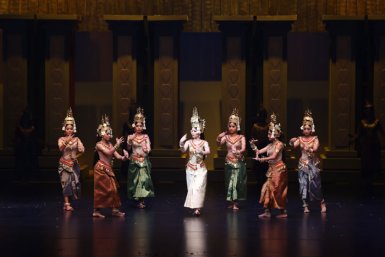 The Apsaras performing at the consecration of the temple. Dancers of Kingdom of Cambodia's Apsara Dance troupe  Vyjayanthi, artisan, presenting her concept of Sheshashayi Vishnu performed by Apsaras, celestial beings for constructing Angkor Temple. Dancers from Apsara troupe of Cambodia This collaborative work is inspired by the timeless carvings of the Apsaras, the celestial beings on the walls of Angkor Wat. The huge cast of Singaporean, Sri Lankan, Indian and Cambodian dancers is a feather in their cap. Era Dance Theatre of Singapore with Osman Abdul Hamid and a new choreographer from Cambodia, Chum Prasoeur of Apsara Dance group, AruSri Art Theatre Dancers of Sri Lanka and Indian dancers with few from Chennai's Kalakshetra, Angkor: An Untold Story is an example of how various cultures come together to create wonderful work of diverse dance forms in a seamless manner. 
Aravinth Kumaraswamy
Devatas are celestial beings, the divine forms. They arouse curiosity. Why were they enshrined in this temple? Aravinth Kumaraswamy was intrigued and coming across monumental work on Angkor Wat's nearly 2000 detailed portraits by research worker Kent Davis, he was inspired to seek this untold story. When he was barely twelve years old, he had seen Kalki's Sivagamiyin Sabatham in which Kalki had told his story through the life of a dancer Sivakami. That sparked the inspiration and he decided to tell the untold story of 12th century artisan dancer Vyjayanthi, who journeyed from Chola Kingdom in India to Angkor, Cambodia. The fictional story revolves round Khmer queen Suryavana who is advised by royal priest Divakar Pandithar to build a temple in order to divert attention of her husband King Suryavarman from going to wars. Divakar suggests bringing from Chola Kingdom in South India, artisans expert in building temples of unparalleled beauty. She is pleased and sends him to South India, where visiting a remote temple he encounters artisan Vyjayanthi, a devotee of Vishnu dancing before Lord Vishnu's image. Divakar convinces her to come to Khmer empire to build a magnificent temple and spread her devotion. As the queen, a devotee of Lord Shiva, and Vyjayanthi, a devotee of Lord Vishnu meet, they are led down the path of conflict between mortal and divine love, and redemption. The dance drama opens with screening of sculpture of Vasuki and after setting of the sun and moon rising, the tintinnabulation of artisan Vyjayanthi, impersonated by Priyadarsini Govind, the ankle bells ringing, her golden figure, with golden crown, walking on the parapet of the temple, one is transported to the mystical world of Angkor Wat. With brief surtitles the story unfolds. The spectacular stage designs show the King Suryavarman watching his army, seated in left hand ground floor balcony, the queen watching the procession from balcony of the horse shoe shaped theatre, royal priest being brought through the auditorium on a palanquin. The audience is riveted watching the dance drama moving smoothly from one act to another. 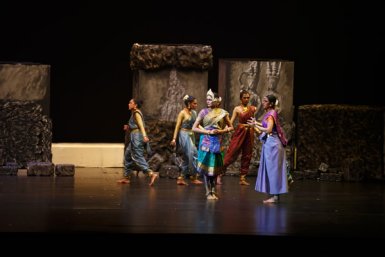 Vyjayanthi (Priyadarsini Govind) in the centre supervising the construction of temple and carvings. Her sakhi Tulasi on left is looking at the sculptures 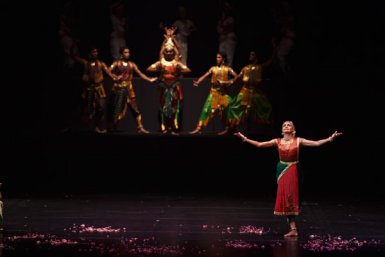 Vyjayanthi describing the Churning of the Ocean to be carved on the walls of Angkor The sets are spectacular, thrones, palanquins, costumes designed faithfully from the temple architecture, sculpture, clothes, ornaments worn by Apsaras and other characters carved on Angkor, recreating glory of the 12th century golden period of King Suryavarman II. Suggestive of temple, palace, and with state of art technology, moving easily, suggesting the region of Cambodia and Chola Kingdom of India, the props moving suggest distances covered by priest Divakaran, encountering Vyjayanthi performing before Lord Vishnu's idols and bringing her to Khmer empire, presenting her before the queen, they walking through the Bantey Serai temples, watching sculptures, narrating stories from Indian mythology and marvelling at its beauty. The artistic and imaginative touches were of dance sculptures coming to life. For instance a frieze of Ravana lifting mount Kailasa, with Lord Shiva and Parvati as well as ganas losing balance, Shiva pressing his toe and restoring balance, his Tandava followed by Ravana's dance to Jatakata, lalata vallari - Ravana stotra, taking his veins from his arm and playing veena, Lord Shiva blessing him and dancers again turning into a frieze, was captivating. Similarly, Vyjayanthi watching Vishnu's avatara as Narasimha and killing of Hiranyakashipu and another of Vishnu Durga, dances in praise of Narasimha and Mahisasuramardini to Ayi Giri Nandini with great intensity. In the court, both the queen and Vyjayanthi's proposals are being discussed through dance, the queen extolling Siva's supremacy, whereas Vyjayanthi suggests Suryavarman as incarnation of Vishnu and presenting plans of temple with incidents of Churning of the Ocean, from which the Apsaras appear. Apsaras are most important motifs of Khmer civilization. The sequence is beautifully choreographed and the entire assembly applauds and approves of Vyjayanthi's ideals. She further elaborates with Asuras and Suras with Vasuki naga as rope, lord Vishnu taking form of Kurma to support mount Meru (Angkor temple symbolizes Meru) with singing of ashtapadi from the Gita Govinda and then events from Ramayana narrating Balivadha etc., are narrated through dance. The Devatas, divine dancers, praise Vyjayanthi for giving them an identity in Khmer history. But the queen is unhappy thinking that this would give Vyjayanthi more importance. Her sakhi Aja Devi further instigates her. On returning from a battle field the King visits the temple site, is pleased at the progress and gives her a pearl necklace as gift. She is pleased thinking the King may be in love with her, but her friend Tulasi brings her back to her senses. Aja Devi wishes to further poison the mind of the queen to show that there is an affair between the King and Vyjayanthi, but does not succeed. But when the temple is completed and the artisans, the people are celebrating, the Queen feels more jealous and angry. Meanwhile, the news of King's death in a battle field reaches all. At that time, a shooting star across the sky is interpreted as a bad omen and the Queen points her finger at Vyjayanthi arousing sentiments against Vyjayanthi's presence as an evil and the rest of the country joins in and accuses her. Vyjayanthi is heartbroken, lets out a heart wrenching cry and disintegrates into a pile of fiery ashes. Before that, she runs hither and thither, begging of people that she is innocent, runs among the maze of stretched arms from where she is unable to escape. It was one of the most imaginative pieces of choreography. The Devatas bring to the notice of the Queen her mistake convincing her that she had acted in haste. Vyjayanthi had wanted to celebrate King Suryavarman as the next avatar of Lord Vishnu and Suryavarman's life and the avatars integrate in the temple, therefore the construction of temple should continue to be known as Vara Vishnuloka. The work is resumed and the temple is built. The Devatas, the Apsaras perform their ritualistic and breathtaking dances and the consecration ceremony of the temple comes to a peaceful end. 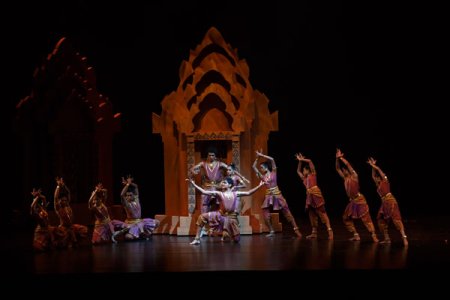 A sequence of Ravana lifting mount Kailasa as seen in a sculpture at Bantey Serai which comes to life through dance 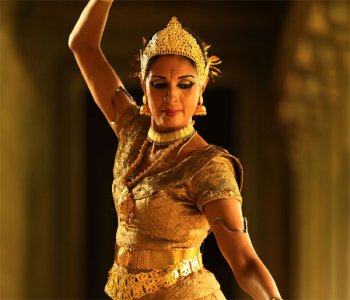 Priyadarsini Govind The dance by the Apsara Dance troupe of the Ministry of Arts and Culture, Kingdom of Cambodia was exquisite and a sight for the gods. So impressive was it with the slow, graceful movements, mudras, lifted arch of the foot at the back, gold ornaments, crowns and costumes that it cast a spell on the audience. The collaboration with Era Dance Theatre Ltd/KRES Dancers led by Osman Abdul Hamid, AeySri Art Theatre, Sri Lanka and Apsaras Arts Ltd., with more than 160 artistes was one of the most rewarding artistic feats on part of the organizers. Dr. Rajkumar Bharathi's music translating choreographers' visions into music is widely acclaimed. The selection of instruments, an ability to arrange music of different regions, Sri Lanka and in particular of Cambodia, highlighting classical music for dance deserves unstinted praise. It contributed immensely to the success of the production. It was teamwork which spoke volumes for this dance drama. Priyadarsini Govind in role of artisan dancer Vyjayanthi, CK Balagopal of Kalakshetra, Anjana Anand as Tulasi, Sabanitha Shanmugasundaram, who was also executive producer and costume designer and played part of Queen Suryavarman, Seema Harikumar as her confidante Aja Devi, and host of dancers, too many to mention made this dance drama a memorable artistic experience. On account of huge cast, one wonders how to make this production accessible to audiences in other cities and countries. As an opera it can be of 2 hours duration, but as a dance drama for international audiences with surtitles also, the ideal time frame should be one hour ten minutes. That would make the dance drama accessible to audiences in various cities and countries. It has high professional values, excellent cast and dancing with captivating music and spectacular settings to merit international exposure. Kudos to Esplanade and Apsaras Arts Ltd.  Dr. Sunil Kothari is a dance historian, scholar, author and a renowned dance critic. He is Vice President of World Dance Alliance Asia Pacific India chapter, based in New Delhi. He is honored by the President of India with Padma Shri, Sangeet Natak Akademi award and Senior Critic Award from Dance Critics Association, NYC. He is a regular contributor to www.narthaki.com, the roving critic for monthly magazine Sruti and is a contributing editor of Nartanam for the past 12 years. Post your comments Pl provide your name and email id along with your comment. All appropriate comments posted with name and email id in the blog will also be featured in the site. |